Growing Teeth: Upgunning The Surface Navy
Posted on
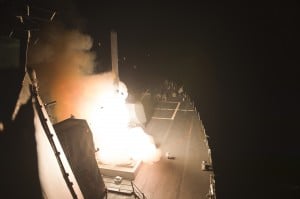
Tomahawk cruise missile launch against Khorasan group in Syria
Last week, the US Navy made waves by announcing two bold ideas for the surface fleet: a new concept of warfighting called “distributed lethality” — “If it floats, it fights” — and a new name for the controversial Littoral Combat Ship — now called a “frigate.”

Bryan Clark
We asked Bryan Clark, a former special assistant to the Chief of Naval Operations, to give his take on both the big ideas and the devils in the details. A veteran of 25 years in the Navy, Commander Clark has served at every level from hands-on enlisted duties to global strategy as head of CNO Greenert’s Commander’s Action Group.
Clark is now a senior fellow at the influential Center for Strategic and Budgetary Assessments. His recent CSBA study Commanding the Seas got a public shout-out last week from the Navy’s Chief of Surface Warfare. “I commend this study to you,” Vice Adm. Tom Rowden told the Surface Navy Association‘s annual conference. “I don’t buy into every single one of the recommendations lock, stand, barrel, [but it] should all get us talking….Bryan I know is a true friend of surface warfare and a great mind.” — The Editors.
Equipping each surface combatant and some non-combatant ships with offensive capability is a great idea and will create a targeting challenge for our potential adversaries. To make this more than just an interesting idea, however, some details need to be addressed.
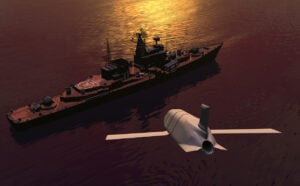
An artist’s depiction of a Lockheed Martin LRASM (Long-Range Anti-Ship Missile) hurtling towards its target.
Offensive Missiles: Getting It Right
First, the offensive missiles need to be a credible threat to the adversary. That means they will need about equal or greater range than the enemy’s effective anti-ship cruise missile (ASCM) range.
Note that the enemy’s effective weapon range will be less than its maximum range. The longer the range of the attack, the longer the missile flight time and the more likely the target can move outside the field of view of the missile; if the targeting data is not good, the enemy will want to shoot at a shorter range to reduce the flight time and reduce the target’s ability to evade.
Overall, this means most enemy long-range ASCMs would likely be fired at 100-150 nm or less. There are several potential missiles available to U.S. forces that could provide more than 150 nm range, such as the Norwegian Kongsberg Naval Strike Missile (NSM).
The offensive missiles will also need targeting data to actually hit anything, so non-combatants in particular will need a way of getting that data. It could be radioed to them by an aircraft or ship, but they may need something like a Link-16 datalink so they could pull the target data off from a MQ-4C Triton drone, NIFC-CA network, etc. This would not be difficult to install, but it would need management attention from surface warfare and Military Sealift Command (MSC) leaders.
Finally, the offensive missile should also be interoperable with other ships, so we don’t have one type of missiles on the Littoral Combat Ship (LCS) and non-combatants but another type on Vertical Launch System (VLS)-equipped ships like our cruisers and destroyers. This is for logistical, training, and combat system commonality reasons. The NSM or other missile could be made VLS-compatible so it could be used across the surface fleet.
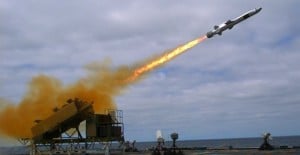
The LCS Coronado test-fires a new anti-ship missile from Norway’s Kongsberg.
Lethality First
The “distributed lethality” discussion of enabling everything that floats to fight didn’t address how we will create lethality to distribute in the existing or planned destroyer and cruiser fleet. We can put box launchers of missiles on LCS and non-combatants, but unless we want cruisers and destroyers to have primarily defensive roles, they will need to be able to conduct offensive operations as well.
That means cruisers and destroyers must adopt an air defense approach that frees up space for offensive missiles in VLS magazines. This approach needs to enable more engagements to be shifted to smaller interceptors and non-kinetic systems such as electronic warfare. That leads to the shorter-range air defense scheme I proposed in my November CSBA report.
The Navy will need to get the most out of each VLS cell. The Raytheon SM-6 Standard Missile, the Kongsberg Naval Strike Missile (NSM), and the Lockheed Martin Long-Range Anti-Ship Missile (LRASM) could all be multi-mission weapons able to handle multiple types of targets, thereby providing more effective capacity from the VLS magazine.
The Navy also needs a new anti-submarine warfare (ASW) missile to enable ships to do offensive ASW outside an enemy submarine’s own weapon range.
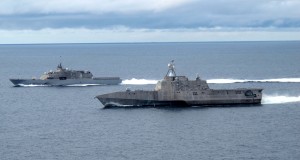
The two Littoral Combat Ship variants, LCS-1 Freedom (far) and LCS-2 Independence (near).
The Limits of LCS
I agree that we could put offensive missiles on LCS and non-combatants and enhance their point air defense systems (e.g. RAM, CIWS) to address the possible increase in attacks they will experience. This doesn‘t solve the problem we will have in wartime of escorting undefended ships (or those with inadequate defenses for the threat environment).
One of the benefits of using VLS to provide offensive missile launchers on LCS would be that you could also load those launchers with longer-range anti-aircraft missiles, such as the Raytheon Evolved Sea Sparrow Missile (ESSM). Such armament would make the LCS an effective escort vessel.
With the Navy’s proposed approach to the “up-gunned” LCS, however, we will not use VLS for the offensive missile launcher. That means we would have a shortage of escorts during any significant conflict.
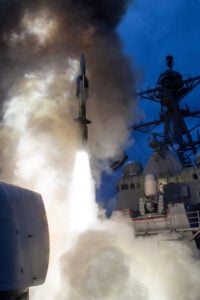
A Vertical Launch System (VLS) fires
The LCS could be an effective escort against surface threats — such as small, fast attack boats — and submarines. The problem is most aircraft, subs, and surface threats will employ anti-ship cruise missiles (ASCMs), making them an air defense problem rather than an anti-surface or anti-submarine warfare problem. That means the LCS would need an air defense system with enough range to protect another nearby ship.
The only current missiles with the range to protect another ship are ESSM-sized and larger. That will require either a box launcher on the deck (such as in European navies) or the Mk-41 VLS. The box launcher is an option, but with another box launcher already going on LCS for an anti-surface-ship missile, there may not be space and weight. That is why Mk-41 VLS makes sense as a multi-mission missile launcher.
Edited 9:30 pm to add quotation from Vice Adm. Rowden.
Subscribe to our newsletter
Promotions, new products and sales. Directly to your inbox.
